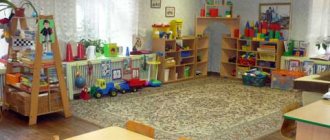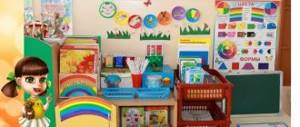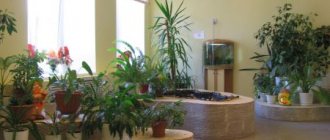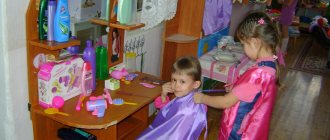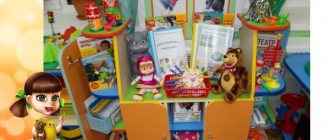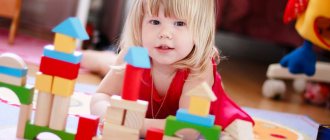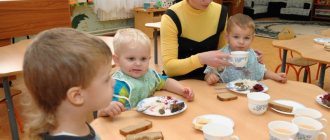Organization of a developmental environment for children’s independent activities, consultation on the topic
Organization of a developmental environment for children’s independent activities
One of the important factors in the development of a child’s independent activity is the environment in which he lives, plays, studies and relaxes. I am trying to organize a diverse developmental subject-spatial environment in my group for children 3-4 years old, which will help them ensure cognitive activity, will correspond to their interests and be developmental in nature. The environment allows every child to find something they like and to believe in their strengths and abilities. Independent activity has great potential for the development of a child’s personality: initiative and activity develop, existing skills are consolidated, self-esteem, self-confidence and self-confidence rise.
Therefore, it is very important to properly organize the developmental environment for children’s independent activities. And in order to properly organize the developmental environment, you need to plan correctly. Planning is a creative and labor-intensive process, but we must remember that the effectiveness of the educational process in a preschool educational institution largely depends on the quality of its planning.
| morning time slot | 1. Introducing a new toy (examining it, determining its place in the play corner, clarifying the rules of use). 2. Enrichment of the subject-developmental environment in the group. 3.Activation of children for independent activities in centers: books, nature, artistic creativity. 4. Enrichment with materials from the “Library” game. 5.Independent activity of children in activity centers. 6.Work in the creativity center: designing homemade books. 7.Experimenting with artistic material (when making illustrations for homemade books). 8.Children’s independent games 9.Work in creativity centers: acting out invented fairy tales and stories with puppet theater toys; 10.S/R games “Shop”, “Hospital”. |
| walk | 1. Games with sand (with snow). 2.Experimentation (sand, water, snow, wind). 3.Modeling. 4.Experiments. 5. Removal of labor equipment on site |
| evening time period | 1. Construction game (improving constructive solutions, working on developing relationships between children). 2. Work on caring for the plants of the group. 3. Work in the book corner (bringing in a new book, reading fiction, looking at illustrations). 4.Introducing a printed board game… 5. Role-playing game “Family”, “Theater”. 6.Free activities for children in creativity centers, books. 7. Selection of books for the exhibition (folk tales, author’s tales) 8.Adding plant care equipment to the natural area. 9. Exhibition of books: Russian folk tales, fairy tales of folk writers. 10.Independent activity of children in activity centers. 11.S/R games “Library”, “Family”. 12. Entering did. game "Collect a fairy tale". |
Methodological development: “Subject development environment in preschool educational institutions.”
The direction of a child’s activity and development depends on us, adults - on how the subject-spatial organization of their life is structured, what toys and teaching aids it consists of, what their developmental potential is, and even on how they are located. Everything that surrounds a child shapes his psyche and is the source of his knowledge and social experience. Therefore, it is we, adults, who take upon ourselves the responsibility to create conditions that contribute to the full realization of the development of children, their capabilities, abilities in all psychophysiological parameters, i.e. the organization of a subject-spatial developmental environment. We, teachers, sought to create conditions in the group for joint activity of children and adults, for independent activity of pupils, taking into account the developmental characteristics of each child.
The developing subject-spatial environment according to the Federal State Educational Standard for Education is part of the educational environment, represented by a specially organized space (rooms, area, etc.), materials, equipment and supplies for the development of preschool children in accordance with the characteristics of each age stage, protection and strengthening their health, taking into account their characteristics and correcting their developmental deficiencies.
The subject-spatial development environment is organized taking into account the requirements of the Federal State Educational Standard, where all five educational areas are clearly visible:
1) social and communicative,
2)
cognitive,
3 ) speech,
4) artistic and aesthetic,
5) physical.
Standard requirements for a developing subject-spatial environment.
The environment should provide the opportunity for communication and joint activities of children and adults, physical activity of children, as well as opportunities for privacy.
Saturation - compliance of the environment with the age capabilities of the children and the content of the Program. Availability of teaching aids (including technical ones), a variety of materials for all types of activities for pupils, experimentation with materials available to children (including sand and water)
Transformability
is the possibility of changing the subject-spatial environment depending on the educational situation.
Accessibility
- free access for all pupils to games, toys, and materials.
Multifunctionality - the possibility of varied use of various components of the environment, suitable for use in different types of children's activities .
Variability - the presence of different spaces (for play, construction, privacy, etc.), a variety of materials, games, toys and equipment, periodic change and the appearance of new items
Safety - compliance of all elements of the environment with the requirements of reliability and quality.
The space of our group is organized in the form of
delimited zones of “centers” , equipped with a large number of educational materials (books, toys, materials for creativity, etc.).
Their equipment changes in accordance with the thematic planning of the educational process. The play environment stimulates children's activity and is constantly updated in accordance with the children's current interests and initiatives. Play equipment is varied and easily transformable. Children and parents have the opportunity to participate in the creation and renovation of the play environment. Activity centers are organized based on the integration of content and activities in the following areas.
Direction: Artistic and aesthetic development.
For the development of children, various pictures, drawings depicting crafts, design options for products, diagrams depicting the sequence of work for making various crafts, etc. have been selected. This gives children new ideas for their productive activities, and also involves mastering the ability to work according to a model . This center contains materials and equipment for artistic and creative activities: drawing, modeling and applications (paper, cardboard, stencils, paints, brushes, glue, pencils, napkins, scissors, coloring books, clay, plasticine, etc.). Most of the listed materials are placed in a specially designated cabinet. If desired, the child can find and use what is necessary to realize his creative ideas, plans, and fantasies. This center has free access.
Direction: Speech development.
includes a book corner. The content of the book corner corresponds to the age characteristics of children of this age and the educational program implemented in the preschool institution. It contains books with works of fiction by children's writers, fairy tales and other literary forms on the topic of the week. The main principle of selecting book publishing products is a minimum of text - a maximum of illustrations. In the book corner there is a photograph of the writer whose work children are currently becoming familiar with and his literary works.
There are various didactic games for speech development, a series of pictures and illustrations to establish the sequence of events, sets of paired pictures for correlation, cut-out plot pictures, etc. A speech development environment is a specially organized environment that most effectively influences the development of various aspects of each child’s speech.
Direction: Cognitive development.
Centers are organized and presented taking into account individual characteristics
children, their sensory experience, information luggage, i.e. theoretical and conceptual awareness of the child. Selected visual didactic material gives children an idea of a holistic picture of the world, the close relationships and interactions of all objects.
includes environmental activities. This center contains various types of indoor plants, on which it is convenient to demonstrate modifications of plant parts, tools for caring for these plants: aprons and sleeves, sticks for loosening, metal children's rakes and shovels, a spray bottle, watering cans, etc. Passports are issued for all plants with symbols. In addition to indoor plants, this center contains various didactic games of an environmental orientation, a series of paintings such as “Seasons”, “Animal and Plant World”, collections of natural materials, dummies of vegetables and fruits, insects, etc. An important component of the corner of nature is a calendar nature and weather.
is represented by a variety of collections (soil, stones, minerals, seeds, cereals, etc.). It contains material for carrying out experimental activities: magnifying glasses, microscopes, compasses, beakers, flasks, measuring cups, watering cans, watches, etc. In the process of experimental activities on growing plants, observation diaries are kept in which the teacher records the conclusions made by the children on results of daily observation. Our little “why girls” will turn into inquisitive testers, conduct simple experiments, and determine the properties of various natural materials.
(toy library)
has important developmental functions. In this center there are normative and symbolic materials: a magnetic board, sets of cards for comparing numbers and quantities, sets of cubes with numbers and numerical figures, various types of mosaics and modern puzzles are presented. A fairly wide selection of games to develop fine motor skills. When choosing games, preference was given to the games' ability to stimulate children's development. Such games are educational games by Voskobovich, “Mongolian Games”, Cuisenaire Sticks, Nikitin’s “Cut Square”, “Dyenesh Logic Blocks”, etc. Game equipment creates a rich, holistic environment with sufficient space for games. The center solves the following tasks:
• purposefully developing children's interest in elementary mathematical activities.
• instilling in children the need to occupy their free time not only with interesting games, but also with games that require mental stress and intellectual effort.
This center contains a variety of entertaining material so that each child can choose a game according to their interests.
The “Moral and Patriotic” center houses the state symbols of the native city of Maykop and Russia. It contains manuals reflecting the multinationality of our Motherland, illustrative material to familiarize children with the sights of our small Motherland - Adygea, examples of folk arts and crafts, etc.
The “construction” (constructive) center , although concentrated in one place and takes up little space, is quite mobile. Its practicality lies in the fact that with the contents of the construction corner (construction sets of various types, large and small wooden construction sets), you can move to any place in the group and organize this activity both with a subgroup of children and individually. Our students independently use diagrams and models of buildings. The center is supplemented with small toys for playing with. The mobility of this center allows children to develop the plot of the game outside of it. This allows our children to feel comfortable in any corner of the group.
The “musical and theatrical” center is an important object of the developmental environment, since it is theatrical activities that help unite the group and unite children with an interesting idea. In the theater, preschoolers open up, demonstrating unexpected facets of their character. There are screens and various types of theaters located here. Children are great artists, so they happily participate in productions and happily act as spectators. It is represented by various types of theaters (puppet, shadow, tabletop, finger). Here there are masks, attributes for acting out fairy tales, elements of costumes for the characters, and the children make their own decorations.
The musical development of a child comes down not only to classes with a teacher, but also to the opportunity to play independently, improvise, and play music freely.
For this purpose, our group has created a musical one
. Which helps my students transfer the experience gained in music classes to other conditions, helps to establish a sense of self-confidence, activity, and initiative.
Direction: Social and personal development.
The equipment and aids are placed in such a way that children can easily select toys and combine them “to suit their creative play ideas.” Due to the fact that the play plans of older preschoolers are very diverse, all stationary play furniture is used multifunctionally for various role-playing games. Universal play layouts are located in places easily accessible to children.
reflects safety at home, on the street (traffic rules) and fire safety. It is equipped with the necessary attributes, toys, and educational games. The creation of such a center in a group helps children become familiar with the rules and norms of safe behavior and develop the values of a healthy lifestyle.
Direction: Physical development.
contains both traditional physical education equipment and non-traditional (non-standard) equipment made by the hands of teachers and parents. This equipment is aimed at developing the physical qualities of children - agility, accuracy, eye, reaction speed, strength qualities. At the present stage of development, there is a need to place games and manuals in this center to introduce older preschoolers to healthy lifestyle skills. This Center is popular among children because it fulfills their need for physical activity. An increase in physical activity has a beneficial effect on the physical and mental development and health of children.
In the noisy space of the playroom there must be an island of peace and quiet. The bedroom also has a “Privacy Corner”
.
If a child is tired of noise and wants to be in silence, he can go to a corner of solitude and relaxation. This is a cozy quiet place. Musical recordings with birdsong, the murmur of a river, the noise of a forest - all this has a beneficial effect on the emotional state of children.
English writer Oscar Wilde said that “The best way to make children good is to make them happy...”. And all our children are good! And by creating a favorable development environment for our children, we want to see them also like this: mastering the basic cultural ways of activity, possessing a positive attitude towards the world, a developed imagination, able to express their thoughts, curious, resilient and physically developed, and most importantly, happy! The advantage of the created environment is that it is possible to involve all children in active independent activities. Each child chooses an activity of interest in any center, which is ensured by the variety of subject content, accessibility and ease of placement of materials. It was noted that pupils have less conflict with each other: they rarely quarrel over games, play space or materials, because they are passionate about interesting activities. The positive emotional mood of children indicates their cheerfulness, openness, and desire to attend kindergarten.
The search for innovative approaches to organizing a subject-development environment continues, the main criteria being creativity, talent and imagination.
Passport of the subject-spatial environment group senior group
In the future we plan to add to this corner of the book:
1. works of folklore (songs, nursery rhymes, proverbs, sayings, fables, shifters, fairy tales);
2. works of modern domestic literature (V.V. Mayakovsky, S.Ya. Marshak, K.I. Chukovsky, S.V. Mikhalkov, M.M. Prishvin, E.I. Charushin, V.V. Bianki, E .Blaginina, Z.Alexandrova, etc.).
3. works of different genres (stories, tales, poems, fairy tales in prose and verse, lyrical and comic poems, riddles), different subjects (children's life: games, fun, toys, pranks; events of social life, people's work; pictures of nature,
ecological problems);
4. works of peoples of other countries;
5. educational games based on fairy tales
6. baby books
7. children's magazines
We plan to replenish the speech corner with:
- Games: “Words-signs” (table wooden, heavy, light...), “Words-actions” (carpenter saws, repairs, planes...), “One - many” (table - tables, cabinet - cabinets...);
— Prepare aids for the development of breathing;
— Games to activate vocabulary: “What is made of what”, “Weather forecast”, “Dress the doll”, etc.
4 Passport for a developing subject-spatial environment in the direction of “Socio-communicative development”
Content
1. Age and individual characteristics of children in speech development
2. Objectives of educational activities
3. Design of RPPS
4. Approximate list of equipment for the implementation of the educational field
5. Prospect for replenishment of the RPPS
Age and individual characteristics of children in terms of social and communicative development
Children are not yet aware of social norms and rules of behavior, but they are already beginning to develop generalized ideas about how they should and should not behave. As a rule, children say hello and goodbye without an adult’s reminder, say “thank you” and “please”, do not interrupt the adult, and address him politely. Children are good at identifying inconsistencies with norms and rules not only in the behavior of others, but also in their own. Thus, the child’s behavior is not so impulsive and direct, although in some situations he still needs a reminder from an adult or peers about the need to adhere to certain norms and rules. At this age, children develop ideas about how girls should behave and how boys should behave. Children have a differentiated idea of their own gender, justifying it based on a number of characteristics (“I’m a boy, I wear trousers, not a dress, I have short hair”). Children have an idea of the characteristics of the most common male and female professions, types of recreation, specific behavior in communicating with other people, and individual female and male qualities. An inquisitive child actively explores the world of objects and things around him, the world of human relationships. Children do this best when they play. Children continue to act out actions with objects, but now the external sequence of these actions already corresponds to reality: the child first cuts the bread and only then places it on the table in front of the dolls. In the game, children name their roles and understand the conventions of the accepted roles. There is a separation between gaming and real relationships. Peers become more attractive and preferred play partners for a child than an adult. At this age, children have well mastered the algorithm for the processes of washing, dressing, bathing, eating, and cleaning the room. Preschoolers know and use for their intended purpose the attributes that accompany these processes: soap, towel, handkerchief, napkin, cutlery. The level of mastery of cultural and hygienic skills is such that children freely transfer them into role-playing games. At this age, the child develops initiative and independence in communicating with adults and peers. Children continue to cooperate with adults in practical matters (joint games, errands), along with this, they actively strive for intellectual communication, which is manifested in numerous questions (why? why? for what?), the desire to receive new cognitive information from an adult. Children have a need for respect from adults and their praise, so the child reacts to adults’ comments with increased sensitivity. Communication with peers is still closely intertwined with other types of children's activities (play, work, productive activity), but situations of pure communication are already noted. Psychological features of children's development Children of the fifth year of life are characterized by non-situational cognitive communication. With it, objects and phenomena of the surrounding world are learned. At this age, an adult must communicate with the child about things that were not in the child’s direct experience. This causes the child to desire to communicate to gain new knowledge and there is a desire to discuss the causes of phenomena. Children aged 6 years strive for independence, but failures discourage them. Therefore, it is very important to correctly determine the degree of complexity of the task and its volume. Some complex skills need to be developed step by step, highlighting individual elements. At this age, children master rules well, which serves as the basis for their organized behavior.
